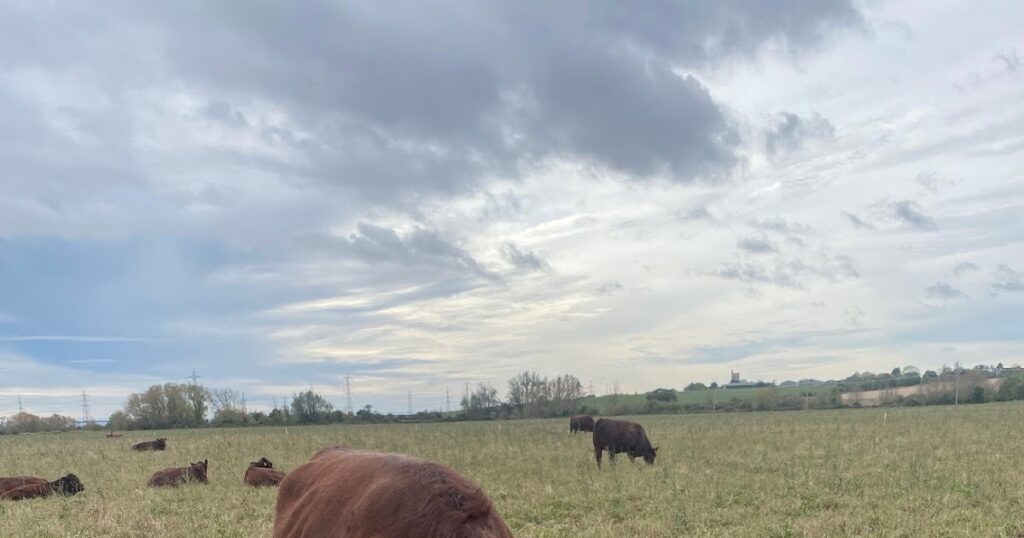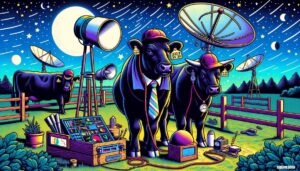6pm. Friday evening. My mobile buzzes on the kitchen table at Mum & Dad’s, disturbing our end-of-week wind-down drink and natter. Grasping my beer by the neck I make my way to the office (the sole room with phone reception) to take the call. I glance down at my iPhone: the display flashes up ‘Westpoint Veterinary Group’, and I know that my vet, Mia, is at the other end with the important results of the previous week’s blood tests on my cattle herd. Will it be a good or a bad start to my weekend…?
It was a bad start. Obviously. As the title of this article forbade.
There are five main diseases in farmed cattle, four of which we were testing for here (my animals have already been checked for bovine tuberculosis). The diseases in question are BVD, IBR, Johne’s and Leptospirosis. My results showed that from the 27 cows tested (we didn’t take bloods on the calves) one had BVD, two had IBR, and one had a maybe result for Johne’s. But as Mia joyfully proclaimed: “you’re all clear for lepto!”. Bugger.
 |
| One of the two cows with IBR |
We also opted to test for neosporosis, which threw up a curveball. One of my favourite cows, 251, mum to the most spectacular heifer calf, Camellia, has managed to contract neospora whilst at the farm here in Fobbing. She was definitely clear last year when she was tested, which shows that there is neospora in the local area, spread by dogs and foxes.
It really shines a light on the importance of picking up dog poo and ensuring dogs are kept on leads
at all times whilst on farms. It also shows how surging wildlife populations through public interference via feeding also has a devastating impact on disease in other animals. So to emphasise again to those who think it is cute to feed foxes / badgers / other wild animals: please don’t. Supplementary feeding alters wild animals within the natural ecosystem with large ripple effects and unexpected consequences.
 |
| It would be devastating if some of my other favourites also contract neospora. This is cow 81, Albert’s mum. She is all clear for now… |
On neospora, the presence of the disease in Fobbing means that my management has to change. It isn’t viable for me to attempt to rid my herd of it if animals are being infected here, and I won’t be able to nullify the host animal when many foxes are fed, plus the landfill serves as an additional breeding ground. I will just have to manage for neopspora in my animals. Neospora reduces fertility and increases abortion in cattle, but some cows seem to manage fine. Therefore I will continue to breed from mine. If they fail to get in calf, or abort their calf then they will be culled from the herd at that stage.
The other diseases are a little tougher to get my head around, and cannot be kept in the herd. Each infected animal must be removed. Thankfully, due to my animals being outside all year round, diseases are less readily conveyed between the herd (hence the low infection rate). Had I put all my cattle in a shed over winter, there is a much higher chance of disease spreading.
For IBR, luckily there is a
marker vaccine which can be administered. Most vaccines are indistinguishable from an infection, so you wouldn’t be able to tell if your animals have the disease or protection against the disease. With IBR, this slightly more expensive marker vaccine enables that determination, so I had to run my herd through the race and crush again to vaccinate them up the nose (intranasally). This is considerably easier said than done, and required me wrestling each animal’s head up to ensure I could blast the 2ml of liquid up an open nostril!
 |
| I was a little busy whilst vaccinating. So whilst I attempt to photographically document everything I do on the farm, all I got was this before shot! |
The vaccine is by no means a quick fix. It only has longevity for six months (and will need readministering at that stage). And whilst it makes an infected cow less transmissive, that cow still has the disease. The infected animals will have to leave the herd soon, and I will continue testing six-monthly for a time until I am certain that disease is irradicated.
 |
| This was the post-vaccine picture, with all the cows back to grazing. |
When it comes to BVD, there is no equivalent marker vaccine (although there is a non-marker). Since I don’t wish to be continually prophylactically vaccinating my entire herd, I have to take the risk that the infected cow, 97, won’t begin spreading the disease. Unfortunately she is in-calf, and won’t be finished nursing that calf for around 12 months. Consequently there is no chance of being BVD-free for at least that time.
And then Johne’s. One of my heifers pinged up as a maybe for that. However, she was a heifer who had been recently TB tested, and apparently that can sometimes cause false positives – fingers are crossed that this is the case here. A re-test in six months to be sure.
I am attempting to achieve a high health status for my herd in the next couple of years, such that they are clear of all these diseases (with the exception of neospora). It’s amazing how much I have learned about cows in the past year, and how differently I would go about growing my herd if I were starting from scratch now. However, hindsight isn’t particularly useful here. And an important point to make is that, whilst these diseases in the herd aren’t ideal, it doesn’t mean there are any safety concerns for consuming meat from animals which had these diseases when they were alive.
 |
| Dad and I also headed to Salisbury to pick up these five heifers from Quentin at Cools Farm. Here they are just settling in in our meadow. |
 |
| Frustratingly, the heifers still had a touch of lungworm necessitating the use of an orally administered ‘drench’. This is broad spectrum and means that their poo will kill (rather than host) certain cool bugs (like dung beetles). However, the risk of lungworm on the farm is too great. This is the definition of targeted treatment, and exactly what these broad-spectrum wormers should be saved and used for. |
Whilst the livestock side of my business has been challenging of late, we have had a rather better time of seeding our wheat. I had ear-marked a 270-acre block for wheat to be sown in the Spring. Spring wheat will tend to yield less than if it is sown in the Winter; however, it often enables better weed control. As discussed in my previous article, there are also potential pitfalls. The November weather has been quite simply magnificent though! Meaning that 185 acres of Mulika Spring wheat have been established really nicely, and are just thinking about poking their little green shoots through the soil surface. We also got our Winter beans in. From an arable perspective I am pretty tickled pink!
Of course, we still had our niggles on this front. The primary one being with applying the pre-emergent spray on the last wheat field. This spray helps prevent weeds from growing in amongst the crop, whilst not damaging the growing crop itself. First of all the sprayer had an engine issue, so we couldn’t get out to the field. A 6am visit from Jonny at G-Engineering got us back up and running for first thing the next morning. Only for Paul to unfold the boom in the field, begin work, and then a section of boom to clean shear through! This time it was my friend Mitch to the rescue with a welder, and finally we got the field finished and put to bed for Winter. Phew! I can’t wait to be organic across my entire holding and to be able to sell the sprayer!
 |
| This one certainly caused me to swear… |
In the middle of the November I had my annual visit from the first year students at Writtle Agricultural College, studying Regenerative Agriculture. I really feel like the farm has a lot to show and demonstrate for RegenAg, and it was all the more enthralling to show the farm to such an engaged group of students. I have my fingers crossed that at least one new employee / co-farmer may come out of this batch.
 |
| The students from Writtle Agricultural College |
 |
| We have had some beautiful, crisp weather of late, when this pond looks spectacular! |
In and amongst the late freneticism of arable and livestock work, we have also been working hard ring-fencing the farm. Paul and a second-year student from Writtle, Morgan, are the ones putting in most of the graft. I am ecstatic at how good the finished product looks up the High Road: 1.4m high mesh, yet to be topped with a single strand of barbed wire. I have a phrase when it comes to cattle: “It’s not a problem if they are out, so long as they aren’t out out”. By which I mean, provided they are still on the farm, it doesn’t matter if they aren’t in the paddock they are supposed to be. This ring fence will provide me with a huge amount of peace of mind. This year’s project is still only two-fifths of what needs doing though, with another 6km planned for next year.
 |
| Some clearance has been necessary to erect the new hedge. At this location, next to the village park, I opted to remove the elm and bramble, since they do little to help wildlife, and are likely to cause issues with pulling the new fence down. Elm succumbs to disease very soon now anyway. |
 |
| I am instead organising a team to come in and plant a dense, diverse hedge in the place of the elm we have ripped out. This will feature many types of fruits and nuts to ensure a plentiful supply of food for the wildlife here at the farm. |
 |
| The fence still needs topping with a single strand of barbed wire, but I am so happy we opted to go with this metal ‘Clipex’ fencing. It looks super smart. And the system of erection is really speedy. |
Winter is meant to be quiet on a farm, but as you can tell that doesn’t yet appear to be the case here at Curtis Farm. The final upcoming job for December is the last of the agroforestry tree planting in Spratts field, completing the project commenced this time last year. The trees are due to arrive on Tuesday 14th December. If anyone would like to volunteer to help with the tree planting that would be much appreciated. The aim will be to plant the 230 trees from Wednesday 15th through Friday 17th. If you wish to lend a hand, please ping me an email or WhatsApp to the contact details below.
















